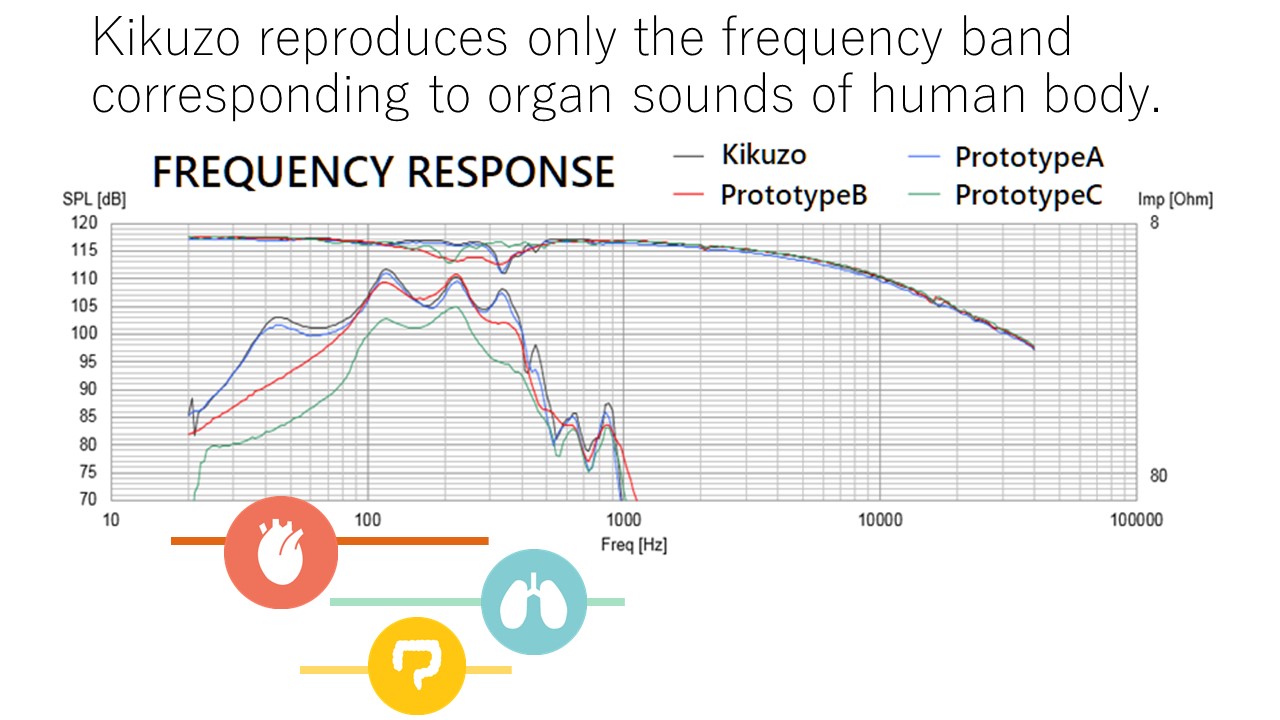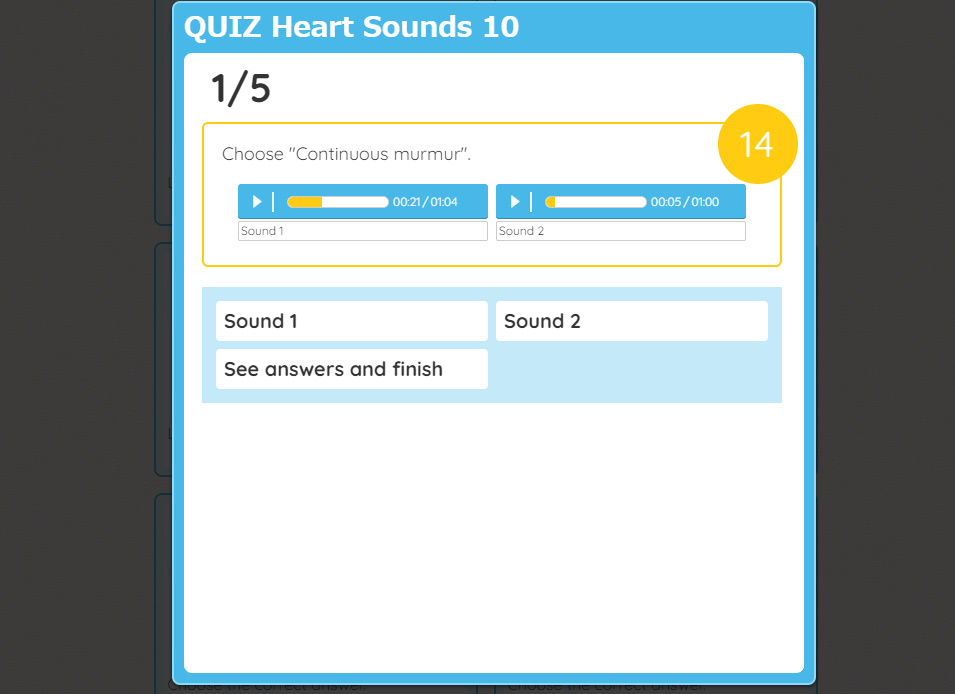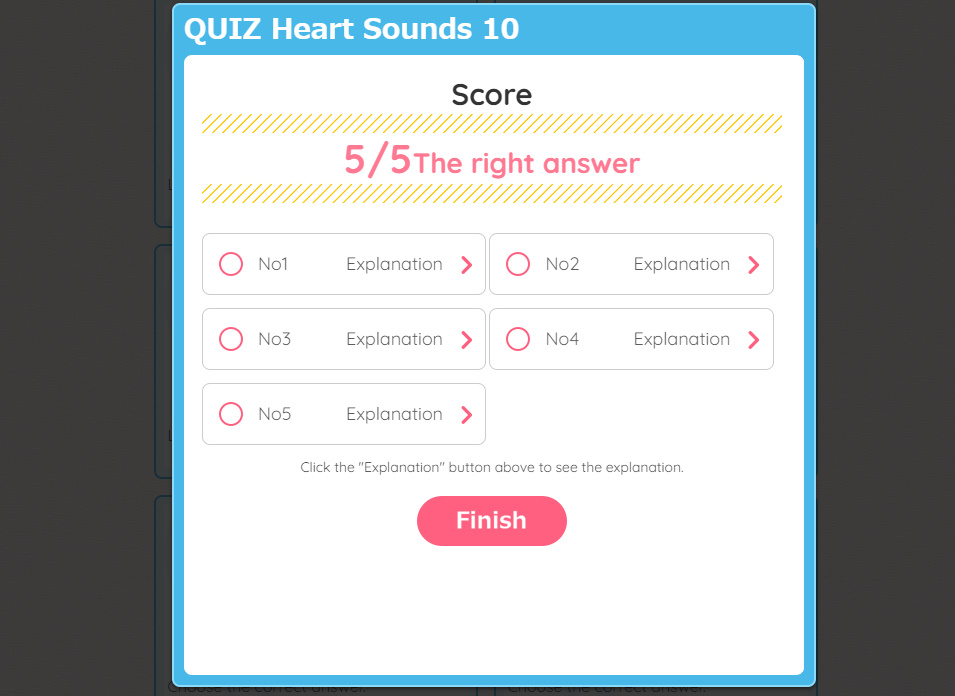Explanations of Kikuzo,
an auscultation speaker, and its sound-library.
Kikuzo is a dedicated auscultation speaker designed to listen to sound with your stethoscope.
(ver.spoken English)
In addition to being handy-sized and easy to carry, it is also characterized by its ability to produce sounds that are almost the same as the living body. The quality of the sound was highly evaluated, and its use spread rapidly in Japan.
The sound feature of Kikuzo from both the sound source and the speaker characteristics point of view.
1.Auscultation sounds technology
Normally, an electronic stethoscope is often used to collect auscultatory sounds, but in that case, environmental sounds and fricative sounds are mixed in when recording. It is extremely difficult to remove the mixed noise by editing. However, we have developed a technology to remove noise and have succeeded in producing a pure and clear auscultatory sound. Therefore, we can produce as many auscultatory sounds in every case we need.

2. The performance of Kikuzo as a speaker.
Even if there is no noise in the sound source itself, electrons may be generated in the smartphone or PC that plays the sound source, and that noise may be mixed into the sound. Many electronic components are packed in a PC device. If the electrons generated from the electronic components are mixed into the sound as noise, normal heart sounds and lung sounds may be heard as heart murmurs and secondary noises. For students, it is difficult to tell whether the noise they hear is electronic noise or abnormal organ sounds. Furthermore, because the sound of electronic noise is of high frequency, it sounds louder than the low-pitched biological sound, and the focus is directed to the electronic noise. Therefore, there is a possibility that you will hear noise without hearing what you should hear.

3. Pure, noise-free and LIFELIKE auscultation sounds for students
In order to process this electronic noise, it was necessary to apply a special processing method to Kikuzo. As a result, we mounted Kikuzo with the feature to shut out electronic noise.
The frequency band played by Kikuzo is displayed on this slide. Heart sounds, lung sounds, and intestinal sounds are known to have frequencies below 1 kilohertz. Higher frequencies are unnecessary bands for auscultation training, so we took these into consideration during its development.
In conclusion, we have developed an auscultation training system that makes pure, noise-free and LIFELIKE auscultation sounds.

4. Example of utilization of Kikuzo
Before the COVID-19 breakout in Japan, Kikuzo was used in combination with simulators. By outputting the auscultation sound of the simulator to Kikuzo from the audio output terminal, all students can now listen to the sound at the same time. This means that students no longer have to wait in line, which leads to reducing wasted time. Kikuzo is also used in ward training.
It is not easy for students to take turns to auscultate hospitalized patients. Therefore, Kikuzo is placed in the ward, and is used to listen to the auscultatory sound of the target disease when confirming the patient’s medical history. It is also used in the same way in nursing colleges and for the education of medical interns. At medical universities, Kikuzo plays a big role in OSCE.

At present, it is difficult to carry out medical education by using the conventional method due to COVID-19. In Japan, there are many places where it is difficult to educate using simulators due to measures such as prohibition of entering the campus. Instead, online education has become more popular.
Kikuzo is also useful in carrying out online classes.
The slide you are looking at has an instructor in the center. The student is on the right. Kikuzo are in the hands of the students, and a stethoscope is applied to Kikuzo.
The instructor plays the auscultatory sound online, and the student listens to the sound in his room using a stethoscope.

This is an example of active learning in which Kikuzo can be used to provide auscultation education with realistic sounds even in remote learning environment. In addition, Kikuzo can also be used as a stethoscope, so palpation training can be performed at the same time.
5. The sound source for auscultation training.
As for the auscultation sound source, 70 kinds of auscultation sounds are currently posted on the dedicated site. All sounds necessary for medical education, such as heart sounds, heart murmurs, lung sounds, secondary noises, intestinal sounds and Korotkoff sounds, are posted.
Sound source player icons are lined up on the screen. When you press the play button, you will hear the sound. The auscultation site (Kikuzosound.com) is here.

You can explain the difference in sound in an easy-to-understand manner while listening and comparing in this way.
Kikuzo has a volume control dial. If it is difficult to hear, such as Sound3, making the sound louder will help you understand the timing of the sound you hear.
Systolic murmur includes mid-systolic murmur, late systolic murmur, and Holosystolic murmur, but you can easily compare them by using this site. These will help students understand.

Sounds required for class can be bookmarked. The bookmarked sound will be displayed on the TOP page. For example, let’s bookmark Heart sound-3. Then, Heart sound-3 is displayed on the TOP page. The order of the sounds on the TOP page can be arranged. You can move important sounds up and use them, and delete unnecessary sounds.
Registering the sounds required for classes on the TOP page will make online learning easier.
The quiz program is useful for students when studying by themselves or in groups.
The quiz is a format in which you listen to the presented sounds and answer the questions.

At the end of the quiz, you can see your results, which is useful for self-checking.

Telemedica recommends to use Kikuzo together with the conventional simulator education.
You can study with Kikuzo in the ward, library, home, or other places where it’s difficult to carry the simulator.
Even if face-to-face education is difficult due to COVID-19, Kikuzo enables online practical education.
We believe that Kikuzo is useful in modern medical education.
The auscultation web site “Kikuzosound.com“
Office: 9-1, Tsutsujigaoka, Aobaku, Yokohama, Japan